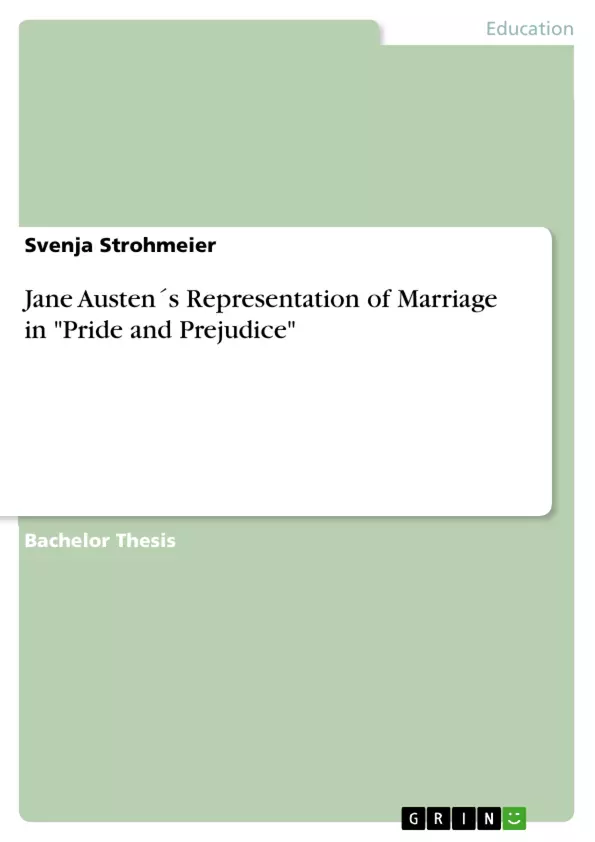“It is a truth universally acknowledged, that a single man in possession of a good fortune must be in want of a wife.” (Austen 1813/1994: 5)
The famous opening sentence of the even more famous novel anticipates the majority of Pride and Prejudice´s content.
This Bachelor thesis examines Jane Austen´s representation of marriage in her novel Pride and Prejudice, published in 1813 in England during the Regency Period.
Pride and Prejudice contains every sort of marriage a person like Jane Austen could imagine in those days: matched marriages, concerned of “making a good match”, the romantic love marriages including marrying under one´s social rank, and the disastrous incident of lovers eloping.
Table of Contents
- Introduction
- Mrs. Bennet and Mr. Bennett: A functional marriage through ignorance
- Charlotte Lucas and Mr. Collins: The Marriage for Convenience
- Lydia Bennett and Mr. Wickham: The Catastrophe of Elopement
- Elizabeth Bennett and Mr. Darcy: The Romantic Marriage
- Jane Bennett and Mr. Bingley: Love marriages
- The Marriages That Never Were: Motifs and Reasons
Objectives and Key Themes
This Bachelor thesis examines Jane Austen's representation of marriage in her novel Pride and Prejudice, published in 1813 in England during the Regency Period. The thesis aims to explore different types of marriages portrayed in the novel, including arranged marriages, love marriages, and elopements. It also analyzes how these marriages reflect the social expectations and realities of women in the Regency era.
- Marriage as a social and economic necessity for women
- The impact of societal expectations on women's choices and opportunities
- Different types of marriage and their consequences
- The role of love, money, and social status in marriage
- The importance of individual happiness and fulfillment within marriage
Chapter Summaries
- Mrs. Bennet and Mr. Bennett: A functional marriage through ignorance: This chapter analyzes the marriage of Mr. and Mrs. Bennett, highlighting their contrasting personalities and the reasons for their union. It explores how their marriage, marked by a lack of genuine affection, was primarily motivated by societal expectations and personal gain.
- Charlotte Lucas and Mr. Collins: The Marriage for Convenience: This chapter examines the marriage of Charlotte Lucas and Mr. Collins, focusing on its pragmatic nature and its implications for Charlotte's social and economic security. It delves into Charlotte's calculated decision to prioritize financial stability over romantic love.
- Lydia Bennett and Mr. Wickham: The Catastrophe of Elopement: This chapter delves into the disastrous elopement of Lydia Bennett and Mr. Wickham, exploring its social consequences and the ramifications for both families involved. It examines the consequences of impulsive decisions and the societal condemnation associated with such behavior.
- Elizabeth Bennett and Mr. Darcy: The Romantic Marriage: This chapter focuses on the developing relationship between Elizabeth Bennett and Mr. Darcy, highlighting their initial prejudice and eventual transformation through self-reflection and understanding. It explores the evolution of their love story, emphasizing the importance of personal growth and overcoming societal barriers.
- Jane Bennett and Mr. Bingley: Love marriages: This chapter examines the relationship between Jane Bennett and Mr. Bingley, showcasing a marriage built on mutual respect and affection. It explores the challenges they face due to social pressures and the importance of genuine love in their enduring connection.
- The Marriages That Never Were: Motifs and Reasons: This chapter explores instances of potential marriages that ultimately did not materialize, highlighting the various reasons behind their failure. It analyzes the impact of social constraints, personal preferences, and societal prejudices on romantic outcomes.
Keywords
This thesis focuses on the representation of marriage in Jane Austen's novel Pride and Prejudice. It examines different types of marriages, including arranged marriages, love marriages, and elopements, highlighting the impact of societal expectations and personal choices on women's lives in the Regency era. Key concepts explored include social status, economic considerations, romantic love, individual happiness, and the role of women in society.
- Citar trabajo
- Svenja Strohmeier (Autor), 2012, Jane Austen´s Representation of Marriage in "Pride and Prejudice", Múnich, GRIN Verlag, https://www.grin.com/document/212357



